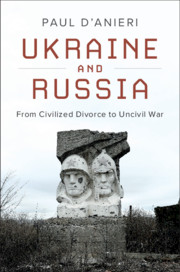Book contents
- Ukraine and Russia
- Ukraine and Russia
- Copyright page
- Dedication
- Contents
- Maps
- Tables
- Acknowledgments
- Additional material
- 1 The Sources of Conflict over Ukraine
- 2 New World Order? 1989‒1993
- 3 Hope and Hardship, 1994‒1999
- 4 Autocracy and Revolution, 1999‒2004
- 5 Reform and Reversal, 2004‒2010
- 6 Viktor Yanukovych and the Path to Confrontation, 2010‒2013
- 7 From Revolution to War, 2013‒2015
- 8 Conclusion: Ukraine, Russia, and the West ‒ from Cold War to Cold War
- Index
8 - Conclusion: Ukraine, Russia, and the West ‒ from Cold War to Cold War
Published online by Cambridge University Press: 01 November 2019
- Ukraine and Russia
- Ukraine and Russia
- Copyright page
- Dedication
- Contents
- Maps
- Tables
- Acknowledgments
- Additional material
- 1 The Sources of Conflict over Ukraine
- 2 New World Order? 1989‒1993
- 3 Hope and Hardship, 1994‒1999
- 4 Autocracy and Revolution, 1999‒2004
- 5 Reform and Reversal, 2004‒2010
- 6 Viktor Yanukovych and the Path to Confrontation, 2010‒2013
- 7 From Revolution to War, 2013‒2015
- 8 Conclusion: Ukraine, Russia, and the West ‒ from Cold War to Cold War
- Index
Summary
Russia’s incursions into Ukraine shattered any remaining illusions about order in post-Cold War Europe, leaving Ukraine and the West struggling to respond while Russia reveled in its fait accompli and started to come to grips with its isolation. What caused the conflict? The summary stresses that multiple factors interacted. From the outset, the actors’ goals were incompatible, even if that was obscured by the euphoria that accompanied the fall of communism. Viewing the situation as one of conflicting goals in a classic security dilemma not only revises our understanding of what happened, but changes our thinking on what the future might look like. While many choices could have been made differently, the grounds for conflict were deeply rooted, and the actors were much more constrained, both internationally and domestically, than the literature focused on blame would have us believe. The implication is that neither schemes to make Ukraine a neutral country nor waiting for Vladimir Putin to pass from the scene is likely to resolve the conflict.
Keywords
- Type
- Chapter
- Information
- Ukraine and RussiaFrom Civilied Divorce to Uncivil War, pp. 253 - 277Publisher: Cambridge University PressPrint publication year: 2019



